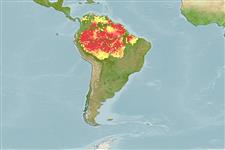Classification / Names
Common names | Synonyms | Catalog of Fishes (gen., sp.) | ITIS | CoL | WoRMS | Cloffa
Actinopterygii (ray-finned fishes) >
Characiformes (Characins) >
Serrasalmidae ()
Etymology: Myloplus: Greek, mylos, -ou = grey mullet + Greek, plus, ploos = movement of a serpent.
Environment / Climate / Range
Ecology
Freshwater; benthopelagic; pH range: 5.0 - 7.0; dH range: ? - 15. Tropical; 23°C - 27°C (Ref. 13371), preferred ?
South America: Amazon and Orinoco River basins; north and eastern Guiana Shield rivers.
Size / Weight / Age
Maturity: Lm ? range ? - ? cm
Max length : 41.5 cm TL male/unsexed; (Ref. 111518); max. published weight: 2.5 kg (Ref. 27188)
Gregarious and non-aggressive (Ref. 27188). Prefers calm zones of main rivers where the vegetation hangs over the river banks. Feeds on the leaves of river plants (Ref. 12225). Possesses powerful dentition that can cause serious bites. Its reproduction has not yet been carried out in captivity (Ref. 27188).
Life cycle and mating behavior
Maturity | Reproduction | Spawning | Eggs | Fecundity | Larvae
The red hooked anal fin of the female is actually a plough. The male has a bilobed anal fin which is designed to wrap around the female's "hook". During spawning, the female inserts the hook into the substrate (e.g., gravel) and ploughs a furrow while laying the eggs with the male in a position next to her with his bi-lobed fin wrapped around the hook as he fertilises the eggs. The female's "hook" is suprisingly strong and can be pushed into coarse gravel (up to the anal opening) without any problem with a shaking body action, the male's bilobed hook folds under the same pressure so they can work in unison (Ref. 55767).
Ortega, H. and R.P. Vari, 1986. Annotated checklist of the freshwater fishes of Peru. Smithson. Contrib. Zool. (437):1-25. (Ref. 6329)
IUCN Red List Status (Ref. 115185)
CITES (Ref. 94142)
Not Evaluated
Threat to humans
Traumatogenic
Human uses
Fisheries: minor commercial; aquarium: commercial
More information
ReferencesAquacultureAquaculture profileStrainsGeneticsAllele frequenciesHeritabilityDiseasesProcessingMass conversion
Tools
Special reports
Download XML
Internet sources
